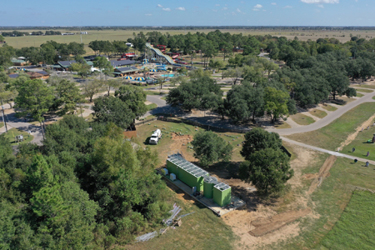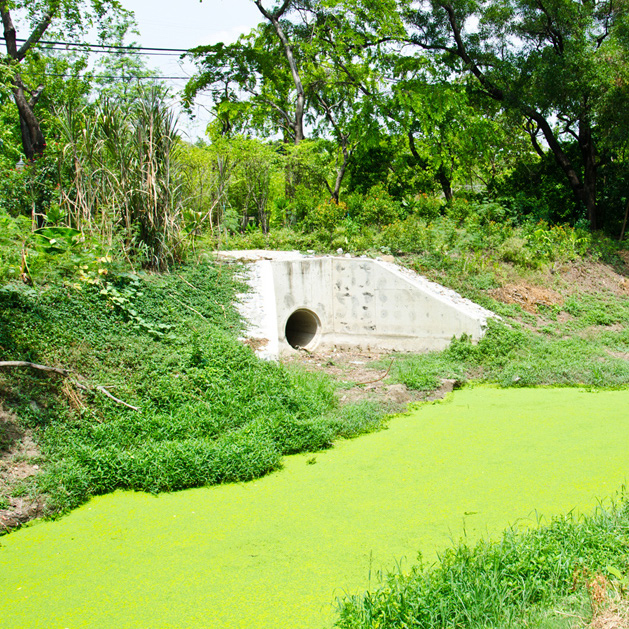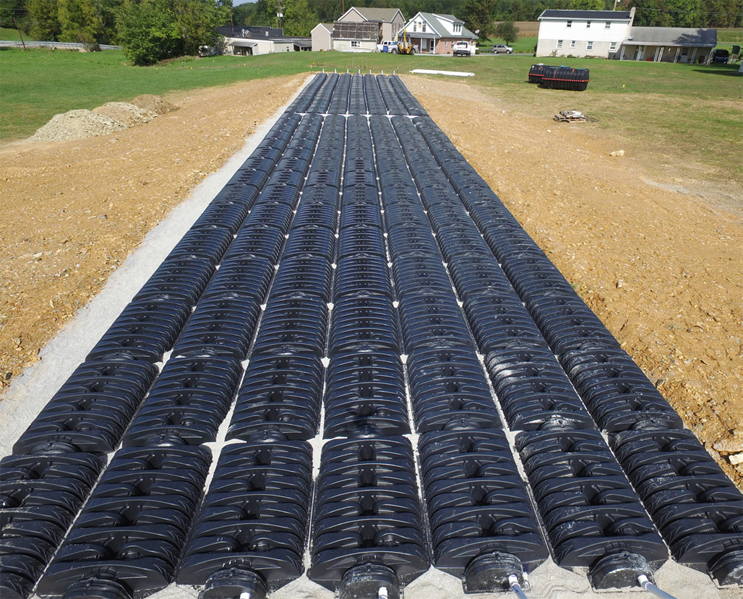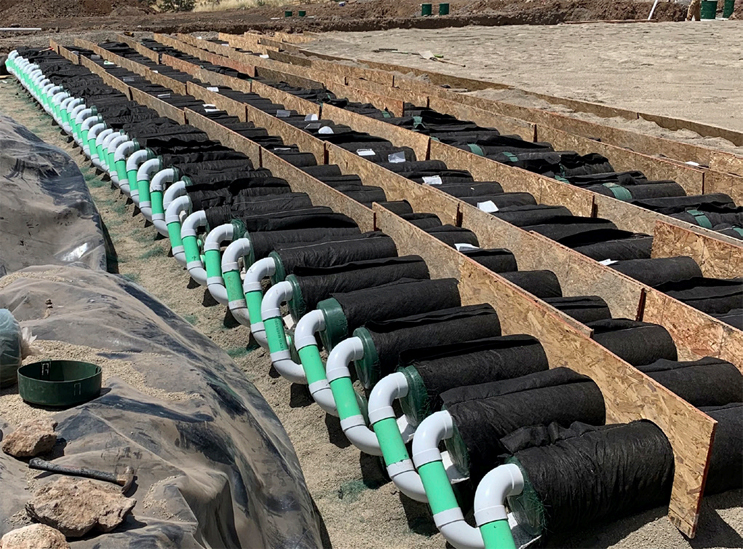When Decentralized Wastewater Is The Wise Choice
By Dennis Hallahan

Centralized wastewater treatment systems have been the dominant — and extremely effective — choice for pollution control historically, but onsite could prove right in many cases today.
Communities face extensive challenges that strain infrastructure and budgets, including population density, commercial growth, traffic, and schooling. One of the most basic community responsibilities is public health. Considering wastewater treatment as a critical public health responsibility, community leaders must incorporate forward thinking that anticipates population density, commercial development, and the age of existing wastewater treatment facilities and systems, and incorporate future wastewater volumes and treatment strategies as part of a master plan. When this does not happen, pollution from wastewater can result in stressed or impaired local waterways, water source or well damage, and negative outlooks for tourism or commercial fisheries. These impacts often catalyze the development of new regulations or treatment limits that either restrict or allow community and commercial growth and enhancements.
When addressing wastewater challenges, communities have several options to consider, including installing a centralized sewer system, extending an existing centralized treatment system by upgrading the treatment plant for additional capacity, or looking to new technology and approaches such as decentralized treatment systems.
A decentralized wastewater treatment (DWT) solution can be the wise choice. DWT is where groundwater is extracted, consumed, treated onsite, and returned close to its point of origin to recharge the local aquifer. Today, DWT systems can treat to the same level as centralized systems and can handle larger flows, with some systems in excess of 1 million gallons per day.
New DWT technologies that use natural approaches are less land-intensive, more cost-effective, and provide effective long-term treatment that can help a community working to create development best practices. The DWT approach can offer a solution for engineers and developers to obtain a code-compliant system for sites with difficult soils, tough terrain, or large recreational and commercial developments in environmentally sensitive areas. With the addition of comprehensive available performance data, DWT systems are increasingly popular with local health officials.
With a decentralized approach, the same treatment technologies utilized by large-scale wastewater treatment plants are available for smaller flows as well. This includes membrane bioreactors (MBR), which have become popular in the last decade. And the community or owner/developer does not have to be at the mercy of the sewer district requiring sewer extensions, nor do they have to wait years for the wastewater treatment plant to be upgraded to have capacity so they can move forward with their project.
Once the darling of communities for wastewater treatment, centralized sewers are now recognized as a primary contributor to the discharge-to-surface-water problems plaguing towns and cities. Centralized treatment has also been to blame for much of the urban sprawl and the resulting loss of community identity that regularly follows the sewer solution.
The centralized approach to wastewater treatment involves collection, treatment, and discharge, typically as a point source. Unfortunately, the collection system can have inflow and infiltration (I&I) from stormwater or groundwater entering the system. This is the case whether the collection system is old or new. When this happens, the collection system’s capacity can be exceeded, leading to a combined sewer overflow (CSO), thus discharging untreated waste directly to a receiving body.
How Does A Community Evaluate What Direction To Take?
Community needs and challenges vary greatly. Here are eight key questions for communities to consider in order to make wise decisions.
- What is the future vision for our community? Sewers offer opportunity for community expansion and business growth, such as high-rise hotels and increased housing density. In some communities, allowing for growth is the goal; however, along with that can come increased traffic, traffic lights at each intersection, strip malls, and a loss of community character. Community planning is at the core of determining not only the five-, 10-, and 20-year vision, but also in selecting the best sustainable wastewater treatment plan.
- What do we anticipate our future wastewater treatment capacity needs to be? With DWT, a community can focus on only treating the areas of town that have the greatest need and phasing in other treatment over time. It allows for lower design flows, smaller dispersal areas, and therefore lower costs. With this approach, the financial burden is placed on those properties where issues are seen or anticipated, not across the board. Centralized sewers do not always offer functional and selective capability.
- What current wastewater treatment challenges exist? Community officials need to accurately assess current community wastewater treatment challenges. Leaking sewers, under-capacity systems, underfunding, watershed issues, groundwater pollution, and regulatory non-compliance all need to be documented. Once that assessment is in place, residents need to be informed about community challenges and provided with detailed information to review, including proposed solutions, associated costs, and short- and long-term impacts. Thorough assessments and proper education will garner public support for needed improvements.

Combined sewer overflows (CSOs) are still common 50 years after the passage of the Clean Water Act. These allow direct discharge of untreated effluent, causing significant health and environmental impacts.
- Will the proposed solution address existing pollution concerns? In most cases when a community is considering a wastewater system upgrade, a pollution concern has been identified and the community may be under orders from the state regulatory agency to address the issue. Sewering a whole town to address a small fraction of the residents may not make economic sense. Be sure that all the alternatives have been reviewed by experts in the areas of technology under consideration and that options are not disregarded without proper vetting.
- When does a new system need to be operational? Rushing into system construction prior to thorough review is never the solution. Getting a new solution up and running requires careful planning and budgeting, whether for individual DWT systems or larger community systems. Costs can vary widely depending on the regulatory requirements and the specific technology. And depending on the issue(s) being addressed, compliance to regulations can be challenging and require expert knowledge and experience.
- What wastewater treatment options are available? There are a lot of specific technologies available, but the primary choice is between a decentralized or a centralized treatment solution — or a melding of the two, which has gained favor in many communities. When evaluating the options, it’s important for the community to employ an expert in each model; otherwise, the solution selected may be biased toward only one of the options.
- What are the short- and longterm costs? Short-term costs to consider for any new treatment system approach include system design, land acquisition, permitting, legal considerations, and construction. Long-term costs include ongoing maintenance, operations, and management, which are often overlooked as a factor when considering options. Also, licensed operators, sampling, power, billing structure, district vehicles such as specialized trucks, and specialized equipment are all cost considerations for the long haul. Decentralized treatment can offer many cost advantages, including smaller design flows, reduced treatment and disposal areas, lower energy consumption, reduced ongoing maintenance, and less regulation related to soil dispersal when compared to heavily regulated single-point discharge to a water body.
- Will the system being considered require professional management? This was previously mentioned, but it is a factor that should be fully explored and estimated as part of many new wastewater treatment approaches that are at a scale to handle the anticipated flows to sustain community growth. Often, professional management will be mandated by regulatory officials. This is a good thing, as it can improve system effectiveness for the long term and provide more extensive monitoring of the system ongoing.

A community drainfield system serves a residential housing project.
Some DWT Solutions To Consider
Community and Commercial Systems — Community or cluster systems are a sustainable option that can be effectively monitored and managed by independent contractors, developers, or existing utilities. They are cost-effective and can easily be hidden and landscaped to integrate into open-space viewsheds. Product and design advances provide improved decentralized treatment in commercial and community systems, including streamlined collection and increased storage capacity to meet peak flows.
Repair and replacement standards, codes, and regulations differ by state and province. Upgrades and replacements can take many forms and there are many solutions available. If there is room on the site, an advanced treatment system (ATS) can be installed with a disposal field. Many types of treatment systems are available, and the approved ATS varies per regulations. For small, undersized, tight lots, it may be best to install septic tank effluent pumping (STEP) systems to convey the effluent to a site with available area and good soil conditions and is located away from the sensitive water body. The point is that the options are varied and understanding the area and the individual sites within it is the only way to make the best recommendation.
On sites with adequate space, the application of engineered wetlands can result in substantial O&M cost savings, especially for systems that have to operate over long periods of time. Engineered wetlands are unique from other treatment processes in that they employ vegetation as part of the treatment process and require very little energy input.
Individual Systems — Onsite septic systems come in many sizes and design configurations, including trench and bed designs, sand filters, and mound systems. The introduction of highly adaptable plastic chambers has expanded the possibilities for specialized system designs and treatment needs. Highly adaptable and effective, chambers can be a key element in septic systems, evapotranspiration beds, community (cluster) systems, constructed wetlands, and large-scale wastewater treatment plants.

A high-flow, small-footprint sand filter will treat to a very high level with a surface discharge. This system is completely passive and requires minimal O&M.
Combined Decentralized And Centralized Treatment Solutions
Municipal Wastewater Treatment Plant Extensions — Providing cost-effective and ecologically sound wastewater treatment when the treatment plant is at capacity and growth is strong is a challenge faced by engineers who design municipal treatment systems. Extending the life of municipal wastewater treatment facilities by adding an auxiliary disposal field or other plant extension to provide effective treatment in communitywide wastewater treatment systems is an example of where centralized and natural treatment systems work in concert.
Conclusion
The decentralized wastewater industry has come a long way and the future looks bright. Various treatment technologies that were once only available for large-scale systems are now effectively being used for smaller systems, and designers and installers have become more educated. Rules and regulations have improved and the allimportant O&M void is being filled by qualified professionals. The design decisions are ultimately the responsibility of the community, and the appropriate solution may incorporate a combination of technologies. The goal is to provide a system that will perform well for the customer, meet regulatory treatment levels to be codecompliant, and protect public health and the environment.
About The Author
 Dennis Hallahan (dhallahan@infiltratorwater.com) has more than 30 years of experience with onsite wastewater treatment system design and construction. Currently technical director at Infiltrator Water Technologies, he is responsible for technology transfer between Infiltrator and the regulatory and design communities, and consults on product research and testing for universities and private consultants. Dennis received his MS in civil engineering from the University of Connecticut and his BS in civil engineering from the University of Vermont. He is a registered professional engineer in Connecticut and holds several patents for onsite wastewater products.
Dennis Hallahan (dhallahan@infiltratorwater.com) has more than 30 years of experience with onsite wastewater treatment system design and construction. Currently technical director at Infiltrator Water Technologies, he is responsible for technology transfer between Infiltrator and the regulatory and design communities, and consults on product research and testing for universities and private consultants. Dennis received his MS in civil engineering from the University of Connecticut and his BS in civil engineering from the University of Vermont. He is a registered professional engineer in Connecticut and holds several patents for onsite wastewater products.
